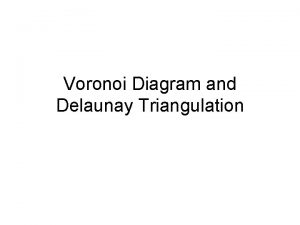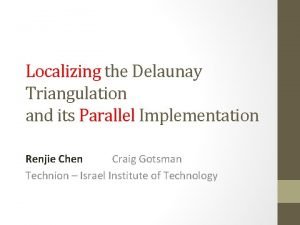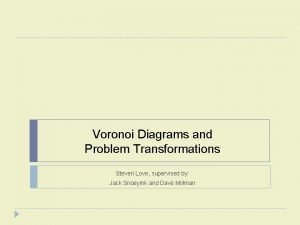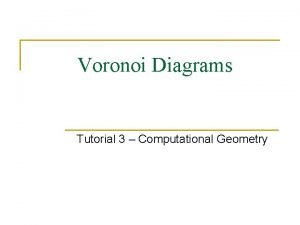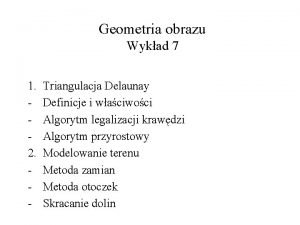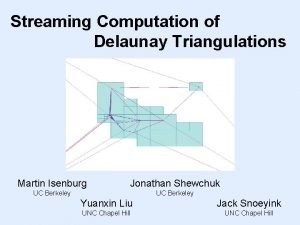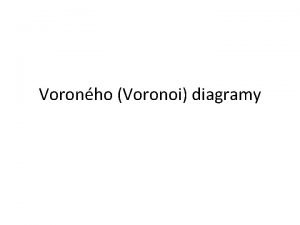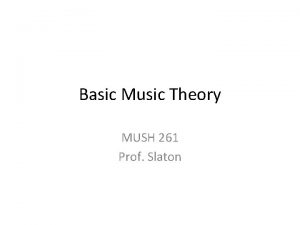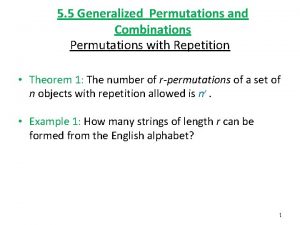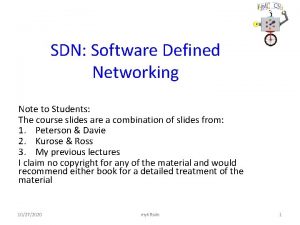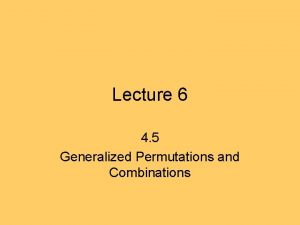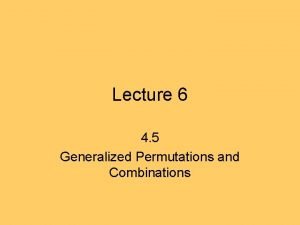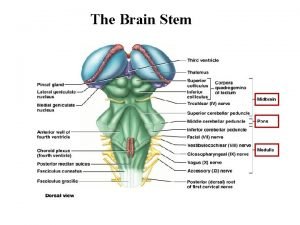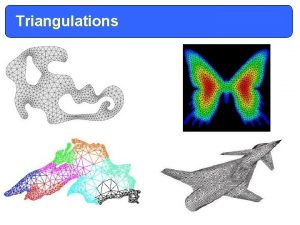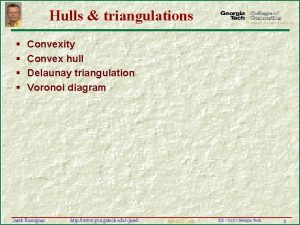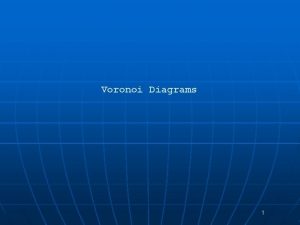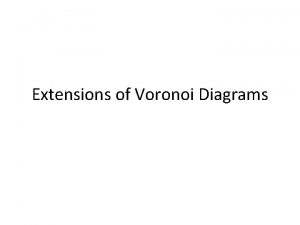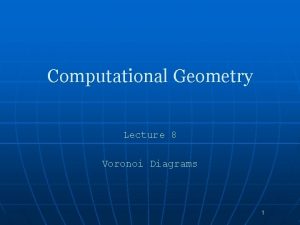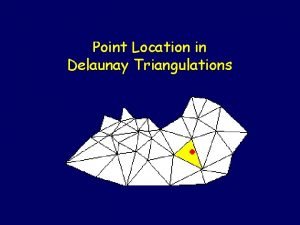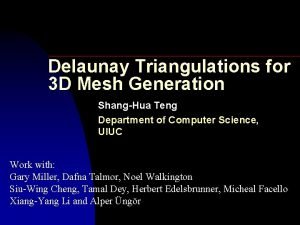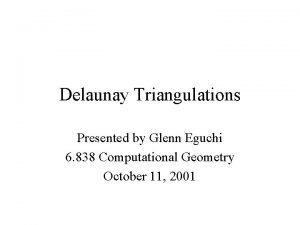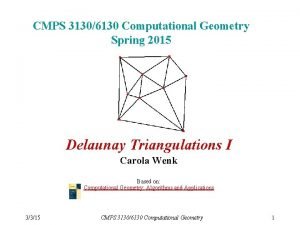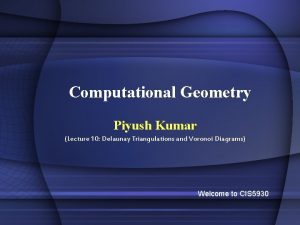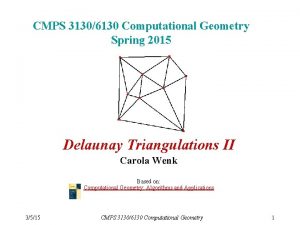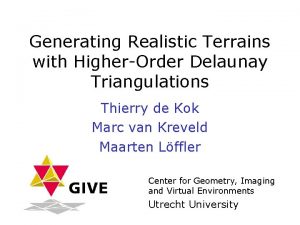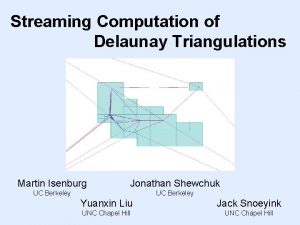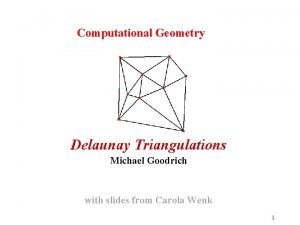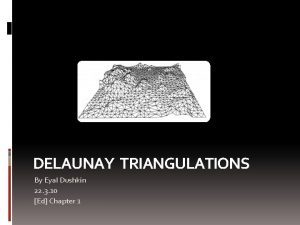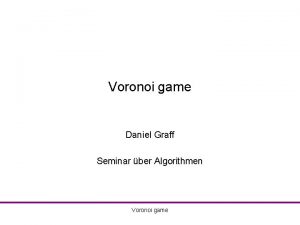Voronoi Diagrams and Delaunay Triangulations Generalized spaces and


















![Symmetric CD vs. Euclidean distance Theorm [Corbalan, Mazon, Recio, and Santos]: If for each Symmetric CD vs. Euclidean distance Theorm [Corbalan, Mazon, Recio, and Santos]: If for each](https://slidetodoc.com/presentation_image_h2/b87a5d43c5f964cbe07d33afe38d8ab5/image-19.jpg)







![Nice metrics n Lemma [Menger]: Let m be a nice metric in the plane. Nice metrics n Lemma [Menger]: Let m be a nice metric in the plane.](https://slidetodoc.com/presentation_image_h2/b87a5d43c5f964cbe07d33afe38d8ab5/image-27.jpg)



![Algorithms n Theorem [Dehne and Klein]: The Voronoi diagram of n point sites under Algorithms n Theorem [Dehne and Klein]: The Voronoi diagram of n point sites under](https://slidetodoc.com/presentation_image_h2/b87a5d43c5f964cbe07d33afe38d8ab5/image-31.jpg)







- Slides: 38

Voronoi Diagrams and Delaunay Triangulations Generalized spaces and distances

Generalized spaces

Generalized spaces - sphere

Generalized spaces - cone

Generalized spaces - cone

Generalized spaces – orbits & quotient space n Let P denote the Euclidean plane and let G be a discrete group of motions on P: a group of bijections, s. t: n n

Generalized spaces – orbits & quotient space n Definitions: n Two points p, p’∈P are equivalent if n The equivalence class, [p], of p is called the orbit of p. n The quotient space, P/G, consists of all orbits. n A connected subset of P that contains a representative out of every orbit called a fundamental domain, if it is convex. n Lemma [Ehrlich and Im Hof]: Let p be a point of P that is left fixed only by the unit element of G. Then its Voronoi region VR(p, [p]) is a fundamental domain.

Generalized spaces – Voronoi diagram of quotient space n Let S 0 denote a set of representatives of S in a fundamental domain D⊂P. n Compute the Voronoi diagram V([S 0]), skipping all Voronoi edges that separate points of the same orbit. n Intersect the resulting structure with the fundamental domain D.

Convex distance functions

Convex distance functions

Convex distance functions n Definition: the set of all points q satisfying d(0, q)≤ 1 is the unit circle. n Properties: The value of d. C(p, q) does not change if both p and q are translated by the same vector. n the triangle inequality: d. C(p, r)≤d. C(p, q)+d. C(q, r) n d. C(p, q)=d. C’(q, p) , where C’ denotes the reflected image of C about the origin. n

Convex distance functions n Definition: Norm p is a function p: V→ℝ s. t: n p(x)≥ 0 (p(x)=0 x=0) p(λx)=|λ| p(x) n p(x+y)≤p(x)+p(y) n n If the set C is symmetric about the origin then d. C is a norm in the plane. n Well-known is the family of Lp (or: Minkowski) norms, p≥ 1, defined by the equation

The Lp norms n L 1(q, r) = |q 1−r 1|+|q 2−r 2| (the Manhattan distance) n Unit circle: n L∞(q, r) = max(|q 1−r 1|, |q 2−r 2|) n Unit circle:

Bisectors under the Manhattan distance (L 1) q p

Strictly convex distance function n Each bisector B(p, q) is a curve homeomorphic to a line. n The strict triangle inequality holds. n Two circles with respect to d. C intersect in at most two points. n Two bisectors B(p, q), B(p, r) intersect in at most one point.

Voronoi diagrams under CD function n Voronoi regions are in general not convex. n Voronoi regions are star-shaped: For each point x∈D(p, q), the line segment px is also contained in D(p, q).

Algorithms

Symmetric CD vs. Euclidean distance n Symmetric CD is equivalent to the Euclidean distance in the sense that: n But:
![Symmetric CD vs Euclidean distance Theorm Corbalan Mazon Recio and Santos If for each Symmetric CD vs. Euclidean distance Theorm [Corbalan, Mazon, Recio, and Santos]: If for each](https://slidetodoc.com/presentation_image_h2/b87a5d43c5f964cbe07d33afe38d8ab5/image-19.jpg)
Symmetric CD vs. Euclidean distance Theorm [Corbalan, Mazon, Recio, and Santos]: If for each set S of at most 4 points the Voronoi diagram VC(S) has the same combinatorial structure as VD(f(S)), for some bijection f of the plane, then f is linear and f(C) = D holds, up to scaling.

Symmetric CD vs. Euclidean distance

CD function in higher dimensions n Properties in 3 -space: n The bisector B(p, q) of two points is a surface homeomorphic to the plane. n Two bisector surfaces B(p, q), B(p, r) have an intersection homeomorphic to the line, or empty. n Theorem [Icking, Klein, Lê and Ma]: For each n>0 there exist C and 4 points s. t. there are 2 n+1 homothetic copies of C containing these points in their boundaries. n The Voronoi diagram of n points in 3 -space based on the L 1 norm is of complexity Θ(n 2), and the diagram in d-space based on L∞ are of complexity Θ(n�d/2�).

Metrics

Metrics n Metric, m, associates with any two points, p and q, a non-negative real number m(p, q). n Properties: m(p, q) = 0 ⇔ p = q. n m(p, q) = m(q, p). n The triangle inequality m(p, r)≤m(p, q)+m(q, r) holds. n

Metrics - example n Suppose there is an air-lift between two points a, b in the plane. Then

Metrics - example n Voronoi regions with respect to this metric m: f a VRm(a) q VRm(q) b VRm(a)

Nice metrics n Definition: A metric m in the plane is called nice if it enjoys the following properties: n A sequence pi converges to p under m iff this holds under the Euclidean distance. n For any two points p, r there exists a point q different from p and r s. t. m(p, r)=m(p, q)+m(q, r). n For any two points p, q: Bm(p, q) is a curve homeomorphic to the line. n The intersection of two bisector curves consists of only finitely many connected components.
![Nice metrics n Lemma Menger Let m be a nice metric in the plane Nice metrics n Lemma [Menger]: Let m be a nice metric in the plane.](https://slidetodoc.com/presentation_image_h2/b87a5d43c5f964cbe07d33afe38d8ab5/image-27.jpg)
Nice metrics n Lemma [Menger]: Let m be a nice metric in the plane. Then for any two points p, r there exists a path π connecting them, such that for each point q on π: m(p, r)=m(p, q)+m(q, r).

Voronoi diagrams based on nice metrics n Lemma (m-star-shaped): Let m be a nice metric. Then each Voronoi region VRm(p, S) is connected: Each mstraight path π from p to some point x∈VRm(p, S) is fully contained in VRm(p, S).

Nice metrics – example (Karlsruhe/Moscow)

Nice metrics – example (Karlsruhe/Moscow)
![Algorithms n Theorem Dehne and Klein The Voronoi diagram of n point sites under Algorithms n Theorem [Dehne and Klein]: The Voronoi diagram of n point sites under](https://slidetodoc.com/presentation_image_h2/b87a5d43c5f964cbe07d33afe38d8ab5/image-31.jpg)
Algorithms n Theorem [Dehne and Klein]: The Voronoi diagram of n point sites under a nice metric in the plane can be constructed within O(nlogn) many steps, using the sweep line approach.

General Voronoi diagrams

Edelsbrunner and Seidel approach n Given: n S, a set of indices {1, 2, …}. n A fixed domain, X. n For each i∈S a real-valued function fi: X→ℝ. n is a hypersurface in the space X╳ℝ. n The Voronoi diagram is the projection onto X of the lower envelope:

Klein approach – Abstract Voronoi diagram n Given: n S, a set of indices {1, 2, …}. n For any two different indices p, q∈S, a bisecting curve J(p, q)=J(q, p) homeomorphic to the line. n The Voronoi region VR(p, S) is defined as the intersection of the open domains D(p, q).

Admissible system n Definition: The system is called admissible iff for each S’⊆S of size at least 3 the following conditions are fulfilled: The Voronoi regions are connected. n Each point of the plane lies in a Voronoi region (or on the Voronoi diagram). n The intersection of two curves consists of only finitely many components. n

Admissible system n Lemma: Let ℐ be an admissible system, and suppose that J(p, q) and J(p, r) cross at the point x. Then J(q, r) also passes through x.

Computing diagram of admissible system n Divide & conquer ☑ n Randomized incremental ☑ n Sweep ☒

Questions? Thank you!
 Voronoi diagram
Voronoi diagram Delaunay triangulation divide and conquer algorithm
Delaunay triangulation divide and conquer algorithm Toxic waste dump problem voronoi
Toxic waste dump problem voronoi Voronoi diagram tutorial
Voronoi diagram tutorial Robert delaunay
Robert delaunay E
E Delaunay triangulation
Delaunay triangulation Martin isenburg
Martin isenburg Pascal delaunay
Pascal delaunay Voroneho diagram
Voroneho diagram Matematika mindenkinek
Matematika mindenkinek Bauhaus poster
Bauhaus poster The interaction diagrams, use case diagrams are called as
The interaction diagrams, use case diagrams are called as Rake symbol in activity diagram
Rake symbol in activity diagram Objectives of dewatering
Objectives of dewatering Backwards treble clef
Backwards treble clef The oval shaped symbols placed on staff
The oval shaped symbols placed on staff Tenor clef lines and spaces
Tenor clef lines and spaces Healthy spaces and places
Healthy spaces and places Healthy spaces and places
Healthy spaces and places Indistinguishable permutations
Indistinguishable permutations Examples of sdn
Examples of sdn Generalized forwarding and sdn
Generalized forwarding and sdn Generalized permutations and combinations
Generalized permutations and combinations Generalized permutations and combinations
Generalized permutations and combinations Generalized forwarding and sdn
Generalized forwarding and sdn Twinspace etwinning login
Twinspace etwinning login Hardened magma squeezed into vertical spaces between rocks
Hardened magma squeezed into vertical spaces between rocks Midbrain pons medulla
Midbrain pons medulla Ollie from small spaces
Ollie from small spaces Occlusion definition in orthodontics
Occlusion definition in orthodontics Dangerous space of neck
Dangerous space of neck Forearm space of parona boundaries
Forearm space of parona boundaries Fascial spaces of the hand
Fascial spaces of the hand Spaces in primary dentition
Spaces in primary dentition Designing spaces for effective learning
Designing spaces for effective learning Sample complexity for finite hypothesis spaces
Sample complexity for finite hypothesis spaces Canine relationship
Canine relationship Danger space of neck
Danger space of neck
